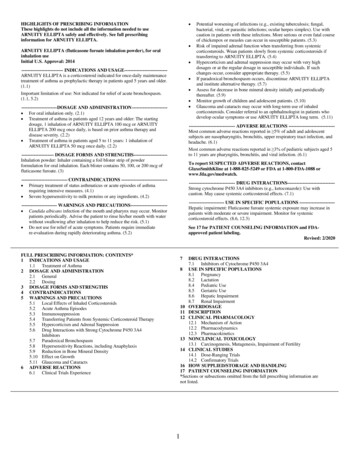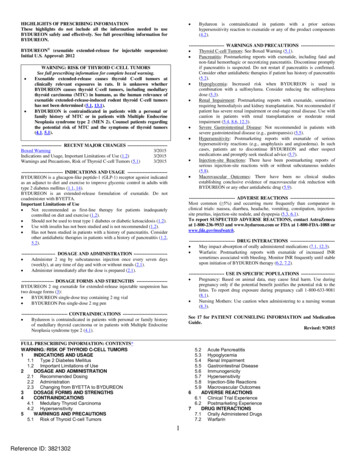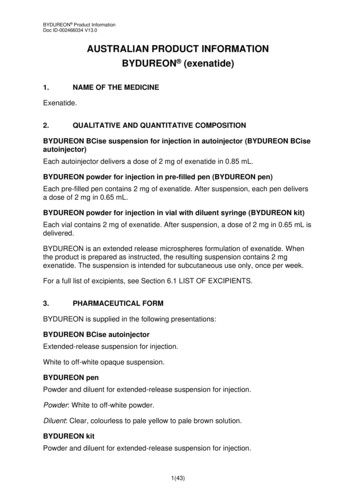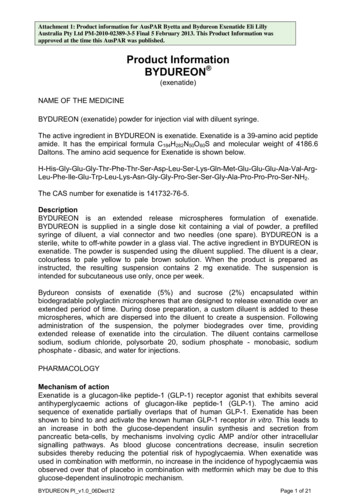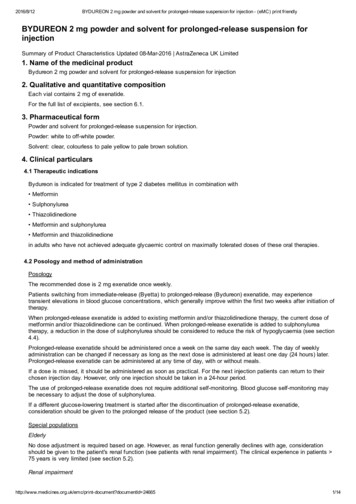
Transcription
2016/8/12BYDUREON 2 mg powder and solvent for prolonged release suspension for injection (eMC) print friendlyBYDUREON 2 mg powder and solvent for prolonged release suspension forinjectionSummary of Product Characteristics Updated 08 Mar 2016 AstraZeneca UK Limited1. Name of the medicinal productBydureon 2 mg powder and solvent for prolonged release suspension for injection2. Qualitative and quantitative compositionEach vial contains 2 mg of exenatide.For the full list of excipients, see section 6.1.3. Pharmaceutical formPowder and solvent for prolonged release suspension for injection.Powder: white to off white powder.Solvent: clear, colourless to pale yellow to pale brown solution.4. Clinical particulars4.1 Therapeutic indicationsBydureon is indicated for treatment of type 2 diabetes mellitus in combination with Metformin Sulphonylurea Thiazolidinedione Metformin and sulphonylurea Metformin and thiazolidinedionein adults who have not achieved adequate glycaemic control on maximally tolerated doses of these oral therapies.4.2 Posology and method of administrationPosologyThe recommended dose is 2 mg exenatide once weekly.Patients switching from immediate release (Byetta) to prolonged release (Bydureon) exenatide, may experiencetransient elevations in blood glucose concentrations, which generally improve within the first two weeks after initiation oftherapy.When prolonged release exenatide is added to existing metformin and/or thiazolidinedione therapy, the current dose ofmetformin and/or thiazolidinedione can be continued. When prolonged release exenatide is added to sulphonylureatherapy, a reduction in the dose of sulphonylurea should be considered to reduce the risk of hypoglycaemia (see section4.4).Prolonged release exenatide should be administered once a week on the same day each week. The day of weeklyadministration can be changed if necessary as long as the next dose is administered at least one day (24 hours) later.Prolonged release exenatide can be administered at any time of day, with or without meals.If a dose is missed, it should be administered as soon as practical. For the next injection patients can return to theirchosen injection day. However, only one injection should be taken in a 24 hour period.The use of prolonged release exenatide does not require additional self monitoring. Blood glucose self monitoring maybe necessary to adjust the dose of sulphonylurea.If a different glucose lowering treatment is started after the discontinuation of prolonged release exenatide,consideration should be given to the prolonged release of the product (see section 5.2).Special populationsElderlyNo dose adjustment is required based on age. However, as renal function generally declines with age, considerationshould be given to the patient's renal function (see patients with renal impairment). The clinical experience in patients 75 years is very limited (see section 5.2).Renal impairmenthttp://www.medicines.org.uk/emc/print document?documentId 246651/14
2016/8/12BYDUREON 2 mg powder and solvent for prolonged release suspension for injection (eMC) print friendlyNo dose adjustment is necessary for patients with mild renal impairment (creatinine clearance 50 to 80 ml/min). Clinicalexperience in patients with moderate renal impairment (creatinine clearance 30 to 50 ml/min) is very limited (see section5.2). Prolonged release exenatide is not recommended in these patients.Prolonged release exenatide is not recommended for use in patients with end stage renal disease or severe renalimpairment (creatinine clearance 30 ml/min) (see section 4.4).Hepatic impairmentNo dose adjustment is necessary for patients with hepatic impairment (see section 5.2).Paediatric populationThe safety and efficacy of prolonged release exenatide in children and adolescents aged under 18 years have not yetbeen established. Currently available data are described in section 5.2 but no recommendation on a posology can bemade.Method of administrationProlonged release exenatide is for self administration by the patient. Each kit should be used by one person only and isfor single use.Prior to initiation of prolonged release exenatide, it is strongly recommended that patients and caregivers be trained bytheir healthcare professional. The “Instructions for the User”, provided in the carton, must be followed carefully.Each dose should be administered in the abdomen, thigh, or the back of the upper arm as a subcutaneous injectionimmediately after suspension of the powder in the solvent.For instructions on the suspension of the medicinal product before administration, see section 6.6 and the “Instructionsfor the User”.4.3 ContraindicationsHypersensitivity to the active substance or to any of the excipients listed in section 6.1.4.4 Special warnings and precautions for useProlonged release exenatide should not be used in patients with type 1 diabetes mellitus or for the treatment of diabeticketoacidosis.Prolonged release exenatide must not be administered by intravenous or intramuscular injection.Renal impairmentIn patients with end stage renal disease receiving dialysis, single doses of immediate release exenatide increasedfrequency and severity of gastrointestinal adverse reactions; therefore, prolonged release exenatide is notrecommended for use in patients with end stage renal disease or severe renal impairment (creatinine clearance 30ml/min). The clinical experience in patients with moderate renal impairment is very limited and the use of prolonged release exenatide is not recommended.There have been uncommon events of altered renal function with exenatide, including increased serum creatinine, renalimpairment, worsened chronic renal failure and acute renal failure, sometimes requiring haemodialysis. Some of theseevents occurred in patients experiencing events that may affect hydration, including nausea, vomiting, and/or diarrhoeaand/or receiving medicinal products known to affect renal function/hydration status. Concomitant medicinal productsincluded angiotensin converting enzymes inhibitors, angiotensin II antagonists, non steroidal anti inflammatorymedicinal products and diuretics. Reversibility of altered renal function has been observed with supportive treatment anddiscontinuation of potentially causative agents, including exenatide.Severe gastrointestinal diseaseProlonged release exenatide has not been studied in patients with severe gastrointestinal disease, includinggastroparesis. Its use is commonly associated with gastrointestinal adverse reactions, including nausea, vomiting, anddiarrhoea. Therefore, the use of prolonged release exenatide is not recommended in patients with severegastrointestinal disease.Acute pancreatitisUse of GLP 1 receptor agonists has been associated with a risk of developing acute pancreatitis. There have beenspontaneously reported events of acute pancreatitis with prolonged release exenatide. Resolution of pancreatitis hasbeen observed with supportive treatment, but very rare cases of necrotising or haemorrhagic pancreatitis and/or deathhave been reported. Patients should be informed of the characteristic symptom of acute pancreatitis: persistent, severeabdominal pain. If pancreatitis is suspected, prolonged release exenatide should be discontinued; if acute pancreatitis isconfirmed, prolonged release exenatide should not be restarted. Caution should be exercised in patients with a historyof pancreatitis.http://www.medicines.org.uk/emc/print document?documentId 246652/14
2016/8/12BYDUREON 2 mg powder and solvent for prolonged release suspension for injection (eMC) print friendlyConcomitant medicinal productsThe concurrent use of prolonged release exenatide with insulin, D phenylalanine derivatives (meglitinides), alpha glucosidase inhibitors, dipeptidyl peptidase 4 inhibitors or other GLP 1 receptor agonists has not been studied. Theconcurrent use of prolonged release and immediate release exenatide has not been studied and is not recommended.Interaction with warfarinThere have been spontaneously reported cases of increased INR (International Normalized Ratio), sometimesassociated with bleeding, with concomitant use of warfarin and exenatide (see section 4.5).HypoglycaemiaThe risk of hypoglycaemia was increased when prolonged release exenatide was used in combination with asulphonylurea in clinical trials. Furthermore in the clinical studies, patients on a sulphonylurea combination, with mildrenal impairment had an increased incidence of hypoglycaemia compared to patients with normal renal function. Toreduce the risk of hypoglycaemia associated with the use of a sulphonylurea, reduction in the dose of sulphonylureashould be considered.Rapid weight lossRapid weight loss at a rate of 1.5 kg per week has been reported in patients treated with exenatide. Weight loss ofthis rate may have harmful consequences. Patients with rapid weight loss should be monitored for signs and symptomsof cholelithiasis.Discontinuation of treatmentAfter discontinuation, the effect of prolonged release exenatide may continue as plasma levels of exenatide declineover 10 weeks. Choice of other medicinal products and dose selection should be considered accordingly, as adversereactions may continue and efficacy may, at least partly, persist until exenatide levels decline.ExcipientsSodium content: This medicine contains less than 1 mmol sodium (23 mg) per dose, i.e. essentially “sodium free”.4.5 Interaction with other medicinal products and other forms of interactionSulphonylureasThe dose of a sulphonylurea may require adjustment due to the increased risk of hypoglycaemia associated withsulphonylurea therapy (see sections 4.2 and 4.4).Gastric emptying The results of a study using paracetamol as a marker of gastric emptying suggest that the effect ofprolonged release exenatide to slow gastric emptying is minor and not expected to cause clinically significantreductions in the rate and extent of absorption of concomitantly administered oral medicinal products. Therefore, nodose adjustments for medicinal products sensitive to delayed gastric emptying are required.When 1,000 mg paracetamol tablets were administered, either with or without a meal, following 14 weeks of prolonged release exenatide therapy, no significant changes in paracetamol AUC were observed compared to the control period.Paracetamol Cmax decreased by 16 % (fasting) and 5 % (fed) and tmax was increased from approximately 1 hour in thecontrol period to 1.4 hours (fasting) and 1.3 hours (fed).The following interaction studies have been conducted using 10 mcg immediate release exenatide but not prolonged release exenatide:WarfarinA delay in tmax of about 2 h was observed when warfarin was administered 35 min after immediate release exenatide.No clinically relevant effects on Cmax or AUC were observed. Increased INR has been spontaneously reported duringconcomitant use of warfarin and prolonged release exenatide. INR should be monitored during initiation of prolonged release exenatide therapy in patients on warfarin and/or cumarol derivatives (see sections 4.4 and 4.8).Hydroxy methyl glutaryl coenzyme A reductase inhibitorsLovastatin AUC and Cmax were decreased approximately 40 % and 28 %, respectively, and tmax was delayed about 4h when immediate release exenatide was administered concomitantly with a single dose of lovastatin (40 mg) comparedwith lovastatin administered alone. In 30 week placebo controlled clinical trials with immediate release exenatide,concomitant use of exenatide and HMG CoA reductase inhibitors was not associated with consistent changes in lipidprofiles (see section 5.1). No predetermined dose adjustment is required; however lipid profiles should be monitored asappropriate.Digoxin and lisinoprilhttp://www.medicines.org.uk/emc/print document?documentId 246653/14
2016/8/12BYDUREON 2 mg powder and solvent for prolonged release suspension for injection (eMC) print friendlyIn interaction studies of the effect of immediate release exenatide on digoxin and lisinopril there were no clinical relevanteffects on Cmax or AUC, however, a delay in tmax of about 2 h was observed.Ethinyl estradiol and levonorgestrelAdministration of a combination oral contraceptive (30 mcg ethinyl estradiol plus 150 mcg levonorgestrel) one hourbefore immediate release exenatide did not alter the AUC, Cmax or Cmin of either ethinyl estradiol or levonorgestrel.Administration of the oral contraceptive 35 minutes after exenatide did not affect AUC but resulted in a reduction of theCmax of ethinyl estradiol by 45 %, and Cmax of levonorgestrel by 27 41 %, and a delay in tmax by 2 4 h due to delayedgastric emptying. The reduction in Cmax is of limited clinical relevance and no adjustment of dosing of oralcontraceptives is required.Paediatric populationInteraction studies with exenatide have only been performed in adults.4.6 Fertility, pregnancy and lactationWomen of childbearing potentialDue to the long washout period of prolonged release exenatide, women of childbearing potential should usecontraception during treatment with prolonged release exenatide. Prolonged release exenatide should be discontinued atleast 3 months before a planned pregnancy.PregnancyThere are no adequate data from the use of prolonged release exenatide in pregnant women. Studies in animals haveshown reproductive toxicity (see section 5.3). The potential risk for humans is unknown. Prolonged release exenatideshould not be used during pregnancy and the use of insulin is recommended.Breast feedingIt is unknown whether exenatide is excreted in human milk. Prolonged release exenatide should not be used duringbreast feeding.FertilityNo fertility studies in humans have been conducted.4.7 Effects on ability to drive and use machinesProlonged release exenatide has minor influence on the ability to drive and use machines. When prolonged releaseexenatide is used in combination with a sulphonylurea, patients should be advised to take precautions to avoidhypoglycaemia while driving and using machines.4.8 Undesirable effectsSummary of the safety profileThe most frequent adverse reactions were mainly gastrointestinal related (nausea which was the most frequent reactionand associated with the initiation of treatment and decreased over time, and diarrhoea). In addition, injection sitereactions (pruritus, nodules, erythema), hypoglycaemia (with a sulphonylurea), and headache occurred. Most adversereactions associated with prolonged release exenatide were mild to moderate in intensity.Since immediate release exenatide has been marketed, acute pancreatitis has been reported with a frequency notknown and acute renal failure has been reported uncommonly (see section 4.4).Tabulated summary of adverse reactionsThe frequency of adverse reactions of prolonged release exenatide identified from clinical trials and spontaneous reports(not observed in clinical trials, frequency not known) are summarised in Table 1 below.The exenatide clinical trials data source comprises 18 placebo controlled trials, 21 active comparator and 2 open labeltrials. Background therapies included diet and exercise, metformin, a sulphonylurea, a thiazolidinedione or acombination of oral glucose lowering agents.The reactions are listed below as MedDRA preferred term by system organ class and absolute frequency. Frequenciesare defined as: very common ( 1/10), common ( 1/100 to 1/10), uncommon ( 1/1000 to 1/100), rare ( 1/10000 to 1/1000), very rare ( 1/10000) and not known (cannot be estimated from the available data).Table 1: Adverse reactions of prolonged release exenatide identified from clinical trials and spontaneous reportshttp://www.medicines.org.uk/emc/print document?documentId 246654/14
2016/8/12BYDUREON 2 mg powder and solvent for prolonged release suspension for injection (eMC) print friendlySystem organ class /adverse reactiontermsFrequency of occurrenceVerycommonCommonUncommon RareVery rareNot knownImmune system disordersX1Anaphylactic reactionMetabolism and nutrition disordersHypoglycaemia (with a sulphonylurea)X1X1Decreased appetiteX1DehydrationNervous system eX1Gastrointestinal disordersX1Intestinal obstructionX2Acute pancreatitis (see section nal painX1Gastroesophageal reflux diseaseX1Abdominal Skin and subcutaneous tissue disordersX2Macular and papular rashPruritus, and/ or urticariaX1Angioneurotic oedemaX2Injection site abscesses and uk/emc/print document?documentId 24665X15/14
2016/8/12BYDUREON 2 mg powder and solvent for prolonged release suspension for injection (eMC) print friendlyX1AlopeciaRenal and urinary disordersX1Altered renal function, including acute renalfailure, worsened chronic renal failure, renalimpairment, increased serum creatinine (seesection 4.4).General disorders and administration siteconditionsInjection site pruritusX1FatigueX1Injection site erythemaX1X1Injection site rashAstheniaFeeling jitteryX1X1InvestigationsInternational normalised ratio increased (seesection 4.4)X21 Rate based on prolonged release exenatide completed long term efficacy and safety studies n 2868 total, (patientson sulphonylurea n 1002).2 Rate based on prolonged release exenatide spontaneous reports data (unknown denominator).Description of selected adverse reactionsHypoglycaemiaThe incidence of hypoglycaemia was increased when prolonged release exenatide was used in combination with asulphonylurea (24.0 % versus 5.4 %) (see section 4.4). To reduce the risk of hypoglycaemia associated with the use ofa sulphonylurea, reduction in the dose of sulphonylurea may be considered (see sections 4.2 and 4.4).Prolonged release exenatide was associated with a significantly lower incidence of episodes of hypoglycaemia thanbasal insulin in patients also receiving metformin therapy (3 % versus 19 %) and in patients also receiving metforminplus sulphonylurea therapy (20 % versus 42 %).Across 11 studies of prolonged release exenatide most episodes (99.9 % n 649) of hypoglycaemia were minor, andresolved with oral administration of carbohydrate. One patient was reported with major hypoglycaemia since he had alow blood glucose value (2.2 mmol/l) and requested assistance with oral carbohydrate treatment which resolved theevent.NauseaThe most frequently reported adverse reaction was nausea. In patients treated with prolonged release exenatide,generally 20 % reported at least one episode of nausea compared to 34 % of immediate release exenatide patients.Most episodes of nausea were mild to moderate. With continued therapy, the frequency decreased in most patients whoinitially experienced nausea.The incidence of withdrawal due to adverse events during the 30 week controlled trial was 6 % for prolonged releaseexenatide treated patients, 5 % for immediate release exenatide treated patients. The most common adverse eventsleading to withdrawal in either treatment group were nausea and vomiting. Withdrawal due to nausea or vomiting eachoccurred in 1 % for prolonged release exenatide treated patients and 1 % for immediate release exenatide treatedpatients.Injection site reactionsInjection site reactions were observed more frequently in prolonged release exenatide treated patients versuscomparator treated patients (16 % versus range of 2 7 %) during the 6 month controlled phase of studies. Theseinjection site reactions were generally mild and usually did not lead to withdrawal from studies. Patients may be treatedto relieve symptoms, while continuing treatment. Subsequent injections should use a different site of injection eachweek. In post marketing experiences, cases with injection site abscesses and cellulitis have been reported.http://www.medicines.org.uk/emc/print document?documentId 246656/14
2016/8/12BYDUREON 2 mg powder and solvent for pr
Bydureon 2 mg powder and solvent for prolonged release suspension for injection 2. Qualitative and quantitative composition Each vial contains 2 mg of exenatide. For the full list of excipients, see section 6.1. 3. Pharmaceutical form Powder and solvent

